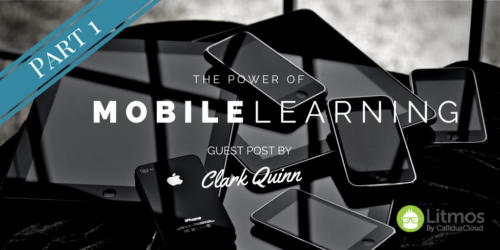The Power of Mobile Learning – part 1 – Guest Post by Clark Quinn
Mobile isn’t a fad; the uptake is undeniable and the ubiquity is obvious. Given that you can no longer ignore mlearning, the question is what are you going to do about it? The short answer is that you need a mobile strategy, but to get there we need some context.
The first thing to consider is what constitutes a mobile device? While most folks recognize them when they see them, it’s important to make a couple of distinctions. The first distinction is the nature of a mobile device. Some early research by Palm (maker of the Pilot, the first broadly successful mobile platform) suggested that mobile devices were used many times a day but for short periods of time, versus a laptop which instead was used only a few times a day but for longer periods. This pattern of usage is important to consider when looking at mobile solutions.
There is now a continuum of devices, from wearables like watches or glasses through smartphones, to tablets. To quell the question of whether laptops count, I posit a distinction that a mobile device has to be able to be used naturally while standing or walking, which rules out anything dependent on a keyboard, but includes the gamut of devices most people recognize as mobile, including dual-purpose devices that can function as a tablet without a keyboard (even if they also have one).
In short, a mobile device is a portable processor equipped with input and output capabilities and mechanisms it to connect to other devices and networks. Key features that were demonstrated early on to be essential include instant-on (with that pattern of quick usage, no one would wait for it to boot), reliability (the data you put into it so you don’t have to remember it has to still be there at the end of the day), and a battery that would last all day (another reason most laptops don’t qualify).
To get to the second issue, we need to go deep for a moment. Our brains are really good pattern matchers and meaning makers; we abstract the gist of things. On the other hand, we’re not very good at remembering rote information and doing complex calculations in our head. Digital technology is the exact opposite, and complements our capabilities very nicely (this is the reason IT has become a ubiquitous tool). Having that capability whenever and wherever we are is the key component of mobile (with an extra opportunity detailed below).
So what are mobile devices used for? When I speak about mobile I conduct an exercise where I ask the audience how they use mobile devices to make themselves more effective. They have the devices, so why? What do they do with them? The usual answers include calendars or events, notes or memos, contacts or addresses, and reminders or todo’s (the four core functionalities that the Palm Pilot originally came with based upon Jeff Hawking’s design research). They also mention browsing, navigation, snapping pictures, and using applications. The devices are serving to augment our capabilities with those digital complements. When I then query “how much of that is a course”, it becomes obvious that the pattern of mobile usage isn’t extended periods of content consumption, and so isn’t really about eLearning. Jason Haag of the ADL’s mobile group has distinguished between mLearning and mobile eLearning, a valuable differentiation. eLearning is really not a natural match to typical mobile usage patterns.
Tablets are a special case. They can be used for content consumption, but a tablet is not the device you have with you all the time, so a smartphone is the prototypical mobile device. There are particular circumstances when tablets make sense, and you want to understand these to make informed decisions about the appropriate focus for your mobile initiatives. The first is when there are limited requirements for movement, or few constraints. For example, in airplane cockpits tablets make a lot of sense. You can take them easily into the cockpit, and then they are quickly accessible. Similarly, on hospital floors you aren’t jumping into and out of vehicle doors and size isn’t a particular issue. A second rationale is for increased screen real estate. As mentioned, we’re pattern matchers, and the ability to show more data to do problem-solving, for instance, may make sense in particular situations. A related case is when you’re collaborating and want to share the screen. For example, tablets make sense for sales personnel when they’re talking to customers.
So if mobile has this pattern of quick usage to complement our skills, how does that map to taking advantage of mobile capabilities? Briefly, mobile’s natural sweet spot is performance support: helping us in the moment. One way to think about it is to recognize that for formal learning we tend to take learners away from the workplace, provide content, and simulate the context to provide practice. With mobile, however, we’re already in the context, and we don’t need to simulate, we just need to help. We also need a slight shift in perspective. Here we aren’t necessarily trying to help the person learn in the moment (although we can), but instead helping them do the task they’re trying to accomplish. Small snippets of content are the types of thing that maximize outcomes with minimal overhead.
Part 2 will be published tomorrow.






